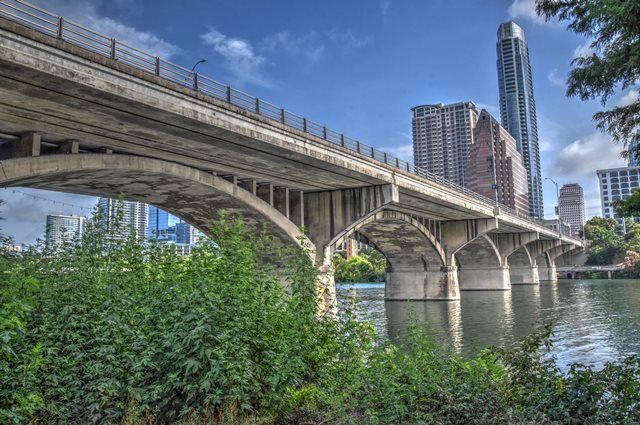We Recommend:
Bach Steel - Experts at historic truss bridge restoration.
BridgeHunter.com Phase 1 is released to the public! - Visit Now
Congress Avenue Bridge
Bat Bridge

Primary Photographer(s): Nathan Holth
Bridge Documented: July 31, 2019
Austin: Travis County, Texas: United States
1909 By Builder/Contractor: William P. Carmichael Company of Williamsport, Indiana and Engineer/Design: Waddell and Harrington of Kansas City, Missouri
1980
119.0 Feet (36.3 Meters)
954.0 Feet (290.8 Meters)
60 Feet (18.29 Meters)
8 Main Span(s)
142270B00425007

View Information About HSR Ratings
Bridge Documentation
This concrete arch bridge has been altered extensively, and one of these alterations has also attracted a colony of bats. In fact, the bridge doesn't even function as an arch anymore. The bridge was widened first in 1956. In 1980, the bridge was even more extensively reconstructed. The deck and the top portion of the columns were cut off and a new prestressed concrete box beam superstructrure was installed on top. Combined with alterations to the piers, the box beam structure is much wider than the concrete arch bridge. As such, hidden under the box beams, the original concrete arch and its columns are still visible, but it is decorative only. A gap is visible betwen the top of the columns and the box beams indicating that the arch plays no structural role whatsoever. This bridge is thus not the best example of historic bridge preservation, although what was done here was still better than full demolition and replacement.
The new prestressed concrete structure is composed of adjacent box beams. Although adjacent, there is an unusual gap between each box beam. These gaps turned out to be exactly the type of habitat that bats look for. Today, these gaps are home to a ton of bats. As a result, the bridge has become a significant local attraction on account of the bats, and is often known as the Bat Bridge.
View Archived National Bridge Inventory Report - Has Additional Details and Evaluation
Above: Historical photo showing bridge as originally built.
![]()
Photo Galleries and Videos: Congress Avenue Bridge
Bridge Photo-Documentation
Original / Full Size PhotosA collection of overview and detail photos. This gallery offers photos in the highest available resolution and file size in a touch-friendly popup viewer.
Alternatively, Browse Without Using Viewer
![]()
Bridge Photo-Documentation
Mobile Optimized PhotosA collection of overview and detail photos. This gallery features data-friendly, fast-loading photos in a touch-friendly popup viewer.
Alternatively, Browse Without Using Viewer
![]()
Maps and Links: Congress Avenue Bridge
Coordinates (Latitude, Longitude):
Search For Additional Bridge Listings:
Bridgehunter.com: View listed bridges within 0.5 miles (0.8 kilometers) of this bridge.
Bridgehunter.com: View listed bridges within 10 miles (16 kilometers) of this bridge.
Additional Maps:
Google Streetview (If Available)
GeoHack (Additional Links and Coordinates)
Apple Maps (Via DuckDuckGo Search)
Apple Maps (Apple devices only)
Android: Open Location In Your Map or GPS App
Flickr Gallery (Find Nearby Photos)
Wikimedia Commons (Find Nearby Photos)
Directions Via Sygic For Android
Directions Via Sygic For iOS and Android Dolphin Browser
USGS National Map (United States Only)
Historical USGS Topo Maps (United States Only)
Historic Aerials (United States Only)
CalTopo Maps (United States Only)


